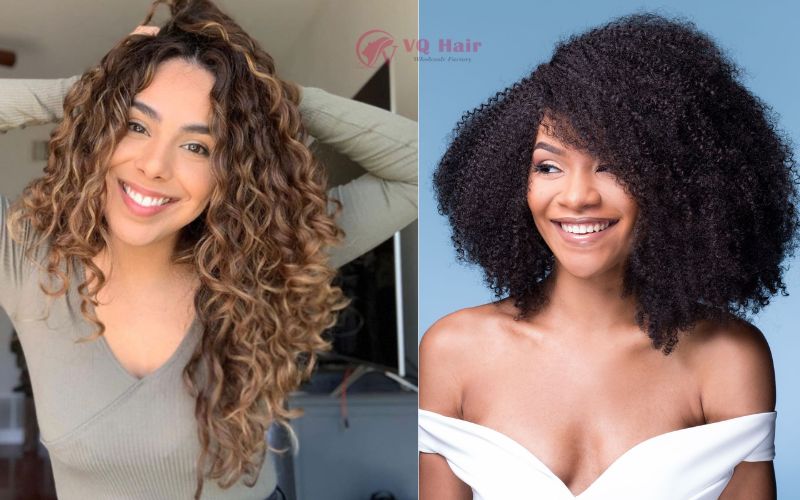What’ s kinky hair weave
Kinky hair weave is a type of hair extension that is made to mimic the texture of tightly coiled or curly hair that is common among people of African descent. The hair is usually made from synthetic fibers or human hair that has been treated to have a kinky texture. This type of weave is often used by individuals who want to add volume, length or texture to their natural hair.
What do kinky weave hair look like?
Kinky straight hair weave typically refers to hair extensions or weaves that mimic the texture of tightly coiled or curly hair, often associated with Black hair. This type of weave hair is designed to match the natural texture of kinky or coily hair, and can vary in length, color, and style. The texture can range from a tight coil to a looser curl pattern, depending on the specific product or brand. Some popular styles for kinky weave hair include twist-outs, braid-outs, and afros.
Yaki straight vs kinky straight, are they similar?
Yaki straight vs kinky straight are similar in some ways, but there are also some differences between yaki and kinky straight. Yaki hair is a type of hair texture that is made to look like straightened or relaxed hair that has been blown out or flat-ironed. It has a slight texture that mimics the look of chemically processed hair. On the other hand, kinky straight hair has a more natural and coarser texture than yaki hair. It mimics the texture of natural hair that has been blown out or straightened without the use of chemicals.
So, while both yaki and kinky straight hair can give the appearance of straightened or blown out hair, they have different textures and are achieved through different methods. Yaki hair is typically achieved through the use of heat tools or chemical processing, while kinky straight hair is achieved through steam processing or other methods that do not involve chemicals.
Learn More: Closure vs frontal sew in : How to find the best hair type for you?
What is curly hair weave?
Curly hair weave refers to hair extensions made of human or synthetic hair that have a curly or wavy texture. These weaves are typically sewn or bonded into a person's natural hair to add volume, length, and texture. Curly hair weaves come in a variety of styles and patterns, including loose curls, tight curls, and spiral curls. They can also be styled with heat tools, such as curling irons and straighteners, to achieve different looks.
What does curly hair look like?
Curly hair typically has a distinct texture characterized by tight or loose spirals, coils, or waves. The curls can vary in size and shape depending on the individual's hair type and genetics. Curly hair may also be frizzy, thick, or have a lot of volume due to the way it grows and the natural oils produced by the scalp. In general, curly hair has a lot of movement and bounce, and can be styled in a variety of ways, including wearing it down or pulled back into a ponytail or bun.
The most common curly hair textures
There are several popular curly hair textures, including:
- Type 2: Wavy hair that has loose, flowing waves and a slight curve.
- Type 3: Curly hair that has tighter, more defined curls. This type of hair is further divided into three subcategories:
- Type 3A: Loose, springy curls with a defined S-shape
- Type 3B: Medium-sized curls that have a tighter S-shape and are prone to frizz
- Type 3C: Tight, corkscrew curls that are densely packed together
- Type 4: Coily hair that has a tight, zigzag pattern. This type of hair is also divided into three subcategories:
- Type 4A: Tightly coiled hair with an S-shaped pattern
- Type 4B: Z-shaped coils that form a sharp angle
- Type 4C: Extremely tightly coiled hair that is densely packed and has no defined curl pattern.
These are the most commonly used classifications for curly hair textures, and they are used by many hair care professionals and brands to determine the best products and treatments for different hair types.
Different between kinky vs curly hair
Kinky and curly hair are both hair types that have a natural texture that is different from straight hair. However, there are significant distinctions between the two.

Curly hair, on the other hand, has a looser curl pattern than kinky hair. It can range from slightly wavy to corkscrew-shaped curls. Curly hair may also have some degree of shrinkage, but not as much as kinky hair. Curly hair is generally more manageable and easier to detangle than kinky hair.
Overall, both kinky and curly hair require special care to maintain their natural texture and health. However, the specific needs of each hair type may differ, and it is important to use products and techniques that are tailored to your hair's unique needs.
Conclusions
We hope you now understand kinky vs curly hair- How are they different. If you are looking for a hairstyle that changes your looks. You can also experiment with both kinky and curly hair.
VQ Hair Factory - Supplying all types of human hair extensions include kinky and curly hair weaves.(1).jpg)
.jpg)
